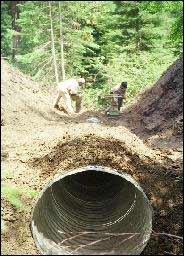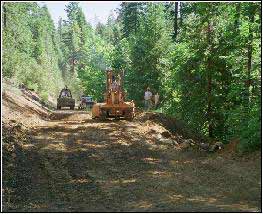Table of Contents
INTRODUCTION
This Annual Report covers the period from
January 1, 1999 to December 31, 1999
The Annual Report contains descriptions of Resource Conservation
District activities and programs. The Report also includes statements
of the District's 1999 revenue and expenditures.
Return to Table of Contents
DIRECTORS
Gregory Lowden, Chairman
Rose Owens, Vice Chair
Patrick Truman, Director
Doug Nowacki, Director
Mike Rourke, Director
Return to Table of Contents
Message from the Manager
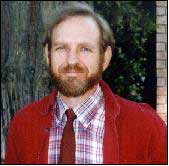 |
Patrick Frost, RCD Manager
The New Year is a time to look back at the past 12 months and a time to look at our future. This past year was a very busy and fruitful year for the Trinity County Resource Conservation District. I will remember it for the way our community pulled together to respond to the fire in Lewiston. I look at it with pride, because the District was there to help the victims of the fire. These rehabilitation efforts are ongoing. We continued our watershed restoration programs in Grass Valley Creek and the South Fork Trinity River; conducted a series of Stream Care workshops for landowners; taught at Weaverville Elementary School’s environmental education camp at Bar 717 Ranch, and conducted Ranch Water Quality management workshops in cooperation with the UC Extension Service. The District has been active in the fuels management arena, assisting landowners in East Branch, Covington Mill and Long Canyon with demonstration projects funded through the California
Department of Forestry.
The Board of Directors of the RCD got ahead on their New Year’s resolutions in December. They adopted a Strategic Plan – a look into the future for the District. This plan reaffirms the District’s commitment to the mission of assisting people in natural resources protection and management. It identifies six key areas: organization, education/outreach, watersheds, forest health, agriculture and recreation/trails. This blueprint will guide us in our efforts to deliver services better, and by necessity will have to be adaptable to the changing circumstances of our environment and economy. This plan tells me that we need to diversify our programs to provide a wider range of technical assistance, and that I need to reach out to more segments of the community. The strategic plan combined with this Annual Report highlights what we have done and how we are trying to broaden the scope of our technical assistance. I am committing to all of you to
redouble my efforts to get out and meet with you. If you would like me to come speak to your group, or you have an idea about a conservation issue that needs to be addressed, just give me a call. I look forward to working with everyone in Trinity County in the coming year.
Return to Table of Contents
The RCD's Role in Lowden Fire Rehabilitation
No one knew that a 100-acre prescribed burn on BLM property near Lewiston would get out of control. Unfortunately that is just what happened on July 2, 1999, the Friday that marked the beginning of the Independence Day weekend. By July 4th approximately 2,000 acres burned, including 23 homes. The fire was swift and intense travelling up steep, dry canyons and over mountainsides covered in a dense mix of oak woodland and evergreen forest.
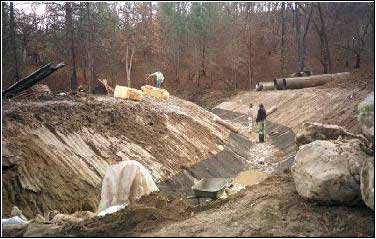 |
Lowden Fire drainage improvement on
landowner’s previous home site
BLM officials turned to the Trinity County RCD almost from the beginning of that disastrous weekend. The District opened its offices for BLM to use as a temporary Victims Claim facility throughout the holiday weekend. As soon as the fire was under control that same weekend, BLM consulted District staff. They looked to the District’s geologist to get a better understanding of the challenges of stabilizing soils dominated by decomposed granite (DG) and to the revegetation coordinator for her expertise in rehabilitating altered DG landscapes. The Trinity County RCD has extensive experience restoring watersheds with similar conditions, most notably the Grass Valley Creek Watershed where the RCD and BLM have been restoration partners for a number of years.
A team of experts from a number of federal agencies in the western states was assembled immediately after the fire. This team, known as the BAER (Burned Area Emergency Rehabilitation) team, had to develop a fire rehabilitation plan for BLM in just a couple of weeks. The team members looked to the RCD and local NRCS staff for technical assistance – help in evaluating the possible effects of the fire on the affected subwatersheds of the Trinity River.
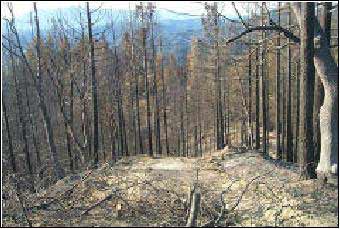 |
Fire Line Rehabilitation Site
The Bureau of Land Management (BLM) requested the assistance of the RCD to tap local expertise and labor to implement restoration projects in order to rehabilitate the burned area of the Lowden Fire and protect adjacent downslope properties.
In August the RCD Board of Directors came to an agreement with BLM authorizing expenditures of up to $1.8 million dollars through federal fiscal year 2002 to implement several aspects of the BAER plan. The Board also agreed to be the local sponsor for the Natural Resource Conservation Service’s Emergency Watershed Protection program for the fire in July.
These projects include:
- Rehabilitate handlines, dozer lines; drop points, staging areas, and unnecessary access roads, which were a result of fire suppression activities.
- Remove debris from existing culverts and replace inadequate drainage culverts.
- Remove debris from basins.
- Remove residual floatable debris from channels and flood plains.
- Reforest by planting native (commercial) conifer species.
- Revegetate using a variety of native non-commercial species.
- Monitor reforestation, aerial seeding, and revegetation success.
- Inventory of private access roads for erosion problems and implement remedial projects to protect property & resources.
- Conduct water quality monitoring to assess the impacts of the fire on the Trinity River and the effectiveness of the erosion control best management practices in the burned area.
A primary function of the Resource Conservation District is to provide assistance to landowners. The District has a solid record of providing the types of assistance that will be needed in the coming months, and possibly years for the rehabilitation of the Lowden Fire burned area. It is the local agency with the expertise in revegetation, soil stabilization, and sediment control. Their experience in the Grass Valley Creek watershed and with decomposed granite is important to the success of the rehabilitation effort. The District has a long history of working closely with the BLM and the other agencies involved in the project. Community outreach and education also have been a critical task to assure that best management practices are used and maintained to protect private property and the natural resources in the area of the fire. Approximately 100 private properties were directly affected by the fire, and the District has the experience and the tools to assist
these landowners whether the problem is controlling erosion, restoring a riparian zone or replanting the burned forests, and at the same time they certainly will not miss the opportunity to work with landowners on building a more fire safe community.
Return to Table of Contents
Forest Health
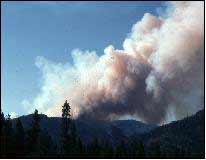 |
Prevention is the answer
The District was an active participant in developing the Trinity County Fire Safe Council. The Fire Safe Council is a proactive coordinated approach to address the risk of catastrophic fires in Trinity County. This group is working towards identifying high risk areas and undertaking strategic planning to reduce those risks on both public and private lands using a locally led planning process.
A Memorandum of Understanding was prepared to facilitate coordinated action with local, state, and federal agencies, watershed-based groups, industry, and private landowners in programs that contribute to healthy ecosystem functions in Trinity County and its watersheds by reducing the risk of catastrophic fire.
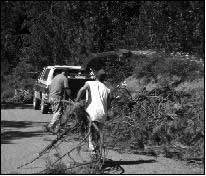 |
Fuels Reduction Project
The goal of the Fire Safe Council is to reduce the risk of catastrophic fire in Trinity County by establishing priorities on a landscape-level scale in order to improve forest health, water quality and quantity, and community well-being.
A strategic planning process and prioritizing fire hazards in Trinity County was begun, utilizing a locally-led planning process. This process will continue in 2000-03 with funds obtained by the District from the State Water Resources Control Board’s Prop 204.
Fuels reduction demonstration projects were implemented by the District in the communities of East Branch and Covington Mill, which also had a Fuels Management Plan prepared for the community by a consulting Registered Professional Forester.
Return to Table of Contents
RCD Chair Honored for Service
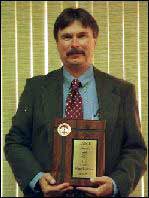 |
Gregory Lowden,
Director of the Year
Greg Lowden, chairman of the District Board, was honored at the Annual Meeting of the California Association of Conservation Districts. He was selected as the Director of the Year for his dedication and service to conserving natural resources through landowner-led efforts.
His nomination described many of his accomplishments, notably his efforts to bring the 1999 Canon National Envirothon to Northern California. The Summer event attracted teams of high school students from over 40 states and three Canadian provinces to compete with their knowledge and skills in forestry, aquatic biology, wildlife, soil science and wildfire. Lowden has volunteered hundreds of hours as a member of the California and national Envirothon committees.
Lowden was appointed by the county board of supervisors to serve on the RCD board in 1992. He has served as Chairman since 1995.
|
Administration
The District’s Board of Directors and administrative staff are responsible for developing and maintaining relationships with partners in the public and private sector to promote delivery of District programs and services, as well as managing the finances of the District.
Patrick Frost, District Manager, spent his 1st year at the RCD and broadened the scope and depth of the District with his experience in resource management, education and outreach.
During 1999 the District employed 13 permanent staff members and eight temporary crew members.
Staff members as well as the Board of Directors were involved in the development of the long range strategic plan, which will assist in guiding District operations. This document defines the District’s goals for the future and how it can best achieve it’s mission. The Board took the necessary look at the District’s purpose, where we are now, where we want to be in the future, and how to arrive at our destination. In the process we examined our strengths, weaknesses, and resource opportunities.
We revised our mission statement, and then developed a vision statement. From there the Board began identifying strategic issues and establishing goals, action items, and the desired results for each issue. The issues were identified with an understanding of current trends present in today’s society and the increased demands on its natural resources. The Board also took into consideration how federal and state governments are looking to local leadership as a means of addressing natural resource issues. We felt it imperative our resource conservation delivery system be strengthened to work with the many private landowners and partners in our community who provide for the health of our watersheds and its economy.
Local Affiliations
- Director Nowacki served as the District Representative on the Trinity County Natural Resources Advisory Council and the Trinity County Fire Safe Council
- Manager Frost served on the County Water Policy Committee
- Directors Owens and Truman served on the RC&D Board
- Chairman Lowden worked closely with the Trail Committee
- The District continued to actively participate in the South Fork Trinity River CRMP
State, Regional and National Meetings
- Chairman Lowden served as Northern Coordinator on the California Envirothon Committee, and helped organize the National Envirothon held in Humboldt County
- Board and Staff attended various meetings throughout the year including: the CARCD Annual Conference, CARCD Board meetings, Area Meetings and Fish & Wildlife Committee meetings, and the NACD Regional and Annual Meetings
- Director Truman served as the CARCD Representative on the Pacific Fishery Enhancement Committee
Return to Table of Contents
| Weaverville Basin Trail System
This project involves a unique trail system, which will circumnavigate historic Weaverville with nearly 50 miles of trail through biologically diverse terrain, over public and private lands, offering many opportunities to interpret historic mining sites, riparian zones, wetlands, old growth forests and timber harvest sites. The District continues to facilitate funding and trail maintenance and development needs. The trail committee functions as a committee of the District Board of Directors.
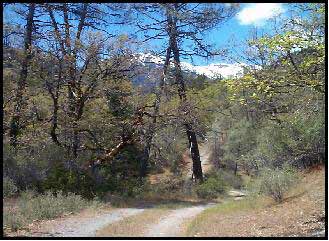 |
A portion of the W. Weaver Creek Trail
Partnering with the RC&D Coordinator, the District hired a part time Trail Coordinator to prepare the Weaverville Basin Trail Master Plan. With the assistance of the NRCS State Landscape Architect, and a UC Davis landscape architect graduate, a draft Master Plan was prepared and reviewed in 1999, and will be finalized Spring of 2000.
Volunteers continue to play an important role in the maintenance and improvement of the trail system, logging in many hours during the “Trail Work Days”. |
Conservation Outreach and Education
The District places particular emphasis on education and outreach, because so much of what we are trying to accomplish in the way of implementing on-the-ground restoration requires a well-informed public, who can be knowledgeable and cooperative in forming partnerships with the District and related agencies.
Because of this, the District continues to devise strategies for reaching the widespread residents of the county, heightening awareness of the District’s activities, and teaching folks important concepts about resource conservation.
The District’s outreach and education programs in 1999 included:
- California and National Envirothon, a resource management competition for high school students
- Weaverville Elementary School Environmental Education Camp
- Riparian Care Workshops
- Ranch Water Quality Workshops
- Tours of Watershed Restoration Projects for Humboldt University Students
- Public Meetings for Input to the Weaverville Basin Trail Master Plan
- Participation in the Trinity County Fire Safe Council
- Participation in the South Fork Trinity River Coordinated Resource Management Planning (CRMP) Meetings
- Successful information booths about RCD Projects at:
- Fourth of July
- Trinity County Fair
- Salmon Festival
- Quarterly Newsletter, the Conservation Almanac distributed to all Post Office Boxes in the County
- Informational Brochures
- Articles in the Trinity Journal about RCD Projects
- Political Advocacy — letters to congressmen, senators, and others urging them to act on behalf of RCD programs and policies
Return to Table of Contents
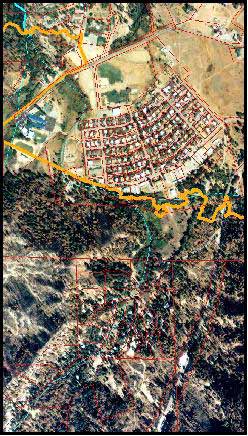 |
Lewiston Fire area
District GIS Services
The District is fortunate to have a Geographic Information Systems (GIS) manager to analyze and manage our data used to create maps crucial to the planning and implementation of projects.
Some examples of how this enhanced our work during 1999 include:
- A GIS coverage of the county was started in order to map necessary local information that will be integrated into a county-wide fire management plan.
- The Board approved a Fee-For-Service policy, allowing the District to contract with the County and consultants for GIS/CAD/Printing services on various projects.
- In July, BLM requested GIS coverages of Lewiston and the Lowden Fire area. These were subsequently used by the District to implement the rehabilitation efforts in Lewiston.
- Maps were created for the inventory crew to collect data. Using Digital Orthophoto Quads as backgrounds, in-house generated maps improved the quality of site identification and road location. Additional maps were created for the planning of roadwork that was completed in Plummer Creek during the Summer work season.
- The Trinity River Basin Fish & Wildlife Task Force awarded a contract to the District to manage the Klamath Resource Information Systems (KRIS) data collected for the Trinity River Restoration Program.
Return to Table of Contents
Grants/Contracts Awarded During 1999
- Trinity River Restoration Program-Grass Valley Creek Watershed Restoration
- ($60,000)-FY 1999
- Continuation of erosion control projects including revegetation projects to reduce sediment to the Trinity River.
- Trinity River Restoration Program-Grass Valley Creek Operation & Maintenance (O&M) and Monitoring
- ($55,000)-FY 1999
- Continuation of operation and maintenance projects, and monitoring of restoration efforts in the Grass Valley Creek Watershed. This includes funds to dredge the Hamilton Ponds as necessary.
- Trinity River Restoration Program-South Fork Trinity River Watershed
- ($210,000)-FY 1999
- Continuation of watershed restoration projects in South Fork Trinity River on public and private lands including erosion control, riparian enhancement such as planting and cattle exclusion fencing, water quantity improvement and water quality monitoring.
- Trinity River Restoration Program-Weaver and Rush Creek Watershed Restoration
- ($50,000)-FY 1999
- Road assessment and improvement and riparian revegetation projects for streambank stabilization in order to reduce the rate of sedimentation into the Trinity River to accelerate the effectiveness of fish and wildlife restoration.
- Fish and Game SB271-Grass Valley Creek Diversion
- ($16,483)
- To eliminate a diversion dam which is a significant fish barrier on Grass Valley Creek by installing pump for landowner’s irrigation needs.
- Fish and Game SB271-Grass Valley Creek Watershed Revegetation
- ($89,388)
- To reduce sediment entering Grass Valley Creek and continue reforestation work in the Grass Valley Creek watershed by planting 150,000 tree seedlings in a 100 acre area of the watershed with scarce vegetation and high sheet and rill erosion.
- Fish and Game SB271-Lower Reading Creek Diversion
- ($7,957)
- To eliminate a diversion dam which is a significant fish barrier on Lower Reading Creek by installing pump for landowner’s irrigation needs.
- CalTrans-Crystal Creek Mineral Springs Juncus Project
- ($12,300)
- Revegetation project utilizing propagated juncus.
- State Water Resources Control Board-Prop 204--Trinity River Watershed Forest Health and Fuels Reduction [with the Watershed Research and Training Center]
- ($400,000)
- Implementation of fuels reduction demonstration projects on private lands and US Forest Service lands. $80,000 has been budgeted for planning and the development of a Strategic Plan for fuel reduction. Proposal includes an MOU to create the Trinity County Fire Safe Council.
- Bureau of Land Management-Grass Valley Creek Revegetation Fall & Spring
- ($138,000)
- Continuation of Grass Valley Creek Watershed revegetation with confiers, shrubs and grasses.
- Natural Resources Conservation Services-Emergency Watershed Protection Program-Lowden Fire Emergency Watershed Restoration
- ($120,000)
- Emergency watershed drainage repair work following the Lowden Fire in Lewiston.
- Bureau of Land Management-Lowden Fire
- Storm Sediment ($20,177)
- Road Inventory ($4,750)
- Revegetation, Non-commercial ($24,975)
- Structure Protection ($30,425)
|
- Fire Line Rehabilitation ($71,404)
- Mulch & Hand Seed ($13,744)
- Water Quality Monitoring ($18,313)
- Revegetation, Commercial ($44,000)
|
Return to Table of Contents
Restoration Projects
Trinity County Resource Conservation District has a long history of providing technical assistance on the restoration of watersheds. Critical elements of restoration include implementation of projects that reduce erosion and the delivery of sediment to rivers and streams. The District contracted with the Trinity River Restoration Program through the Bureau of Reclamation to implement the rehabilitation of the Grass Valley Creek and South Fork Trinity Watersheds.
Grass Valley Creek Watershed
Seven sediment collection basins were cleaned at various locations throughout the Grass Valley Creek Watershed during the winter. The basins collect sediment derived from road cuts producing a substantial amount of sediment that would normally be deposited into a streamcourse.
Partnering with CA Department of Fish & Game, an 8-inch pipeline was installed to assist an irrigation pump at Hamilton Ponds operate efficiently. The pump will be used to revegetate the DG spoils at the Ponds and for other projects on adjacent BLM land.
At the request of BLM, erosion control specifications were prepared by the District, for a bid package on a power line extension project on Hoadley Peak.
NRCS engineering, CA Department of Fish & Game and the District worked with a landowner on the Trinity River to construct a fish-friendly irrigation system.
South Fork Trinity Watershed
Approximately 90 miles of road in the South Fork Trinity River Basin were inventoried during the Summer of 1999. Covering both public and private roads between Forest Glen and above the Hyampom Valley, the District inventory crew documented information including, evaluation of culvert capacity, diversion potential, road drainage and maintenance needs.
Inventories of roads results in prescriptions designed to reduce delivery of sediment to streams in the South Fork Basin. The District’s Implementation Crew spent Summer and Fall 1999 working on 28 miles of road drainage improvements within the Plummer Creek watershed. The work included upgrading undersized culverts, replacing crushed culverts, installing cross road drains, constructing critical dips, removing culverts and other road maintenance needs. Three roads were decommissioned, totaling 2.4 miles.
Hayfork Valley
A 3,500 ft. cattle exclusion fence was built on private property to protect the riparian zone along Salt Creek.
Temperature gages were installed on six sites throughout the Hayfork Valley to monitor water quality.
Other Landowner Assistance
The District provided technical assistance to 41 land owners throughout the county.
- The crew provided erosion control services to a contractor developing a 24 parcel subdivision in Weaverville .
- Five used culverts were donated to a rancher in Hyampom. His road network was failing and sediment was being deposited in a tributary to Olsen Creek.
- To address a severe cutbank erosion problem, the District provided corrective measures including an overside drain and flume material.
- The District’s No Till Drill was rented to various landowners throughout the County.
- Fuels reduction work was implemented on East Branch Road in Weaverville, and in Covington Mill, as part of a CDF Forest Stewardship Grant .
Return to Table of Contents
Revegetation Projects
The success of restoration projects is closely linked to the re-establishment of native vegetation. The District expanded its revegetation programs and native plant nursery during 1999, in an effort to better serve its constituents
Grass Valley Creek
Revegetation work continued in the Grass Valley Creek (GVC) watershed with a total of 112,890 conifers planted in subwatersheds 15 and 16, during the 1999 Spring season. The Fall planting season lasted seven weeks with a total of 146,513 seedlings and grass plugs planted in subwatersheds 15, 16 and 17.
Lowden Fire Rehabilitation
The District provided technical assistance to the BLM team on the revegetation of the fire to reduce erosion and restore the landscape. The BLM contracted with the District to plant conifer and non-commercial species on private lands affected by the Lowden fire.
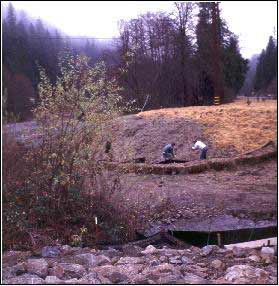 |
Revegetation along highway 299 following CalTrans roadwork
Weaverville Basin
Following CalTrans road and bridgework along Little Brown’s Creek, the District was contacted to develop a plan to revegetate the disturbed areas along Highway 299. The revegetation sites were covered with a 4 to 6 inch layer of topsoil, and a combination of tree and shrub species of varying ages were planted. A previous CalTrans project was monitored and maintained throughout the 1999 growing season. 82 trees planted in culvert pipe planters imbedded in rip rap revetments, were watered regularly to improve survivability.
Monitoring
The long-term success of any revegetation program relies on evaluating the survivability of planted materials. This year’s monitoring included 17 sample sites selected to monitor seedling survivability in the GVC watershed. This included shrub and grass plug monitoring, consisting of flagging 50 seedlings of each species for future identification. Additionally, the District will be monitoring the responses of vegetation to the fire and the success of plantings. An important role of monitoring is to guide replanting efforts in future years.
Hayfork Valley
A riparian enhancement project was implemented in the Hayfork Valley on Carter Gulch. Himalayan blackberry was removed from the slope of the gulch and planted with a combination of native plants.
Landowner Assistance
The revegetation coordinator visited and/or provided assistance to 31 private landowners.
Return to Table of Contents
TRINITY COUNTY RESOURCE CONSERVATION DISTRICT
Statement of Revenues and Expenditures
For the period January 1, 1999 through December 31, 1999
Revenues:
Contract Revenue
Fees for Service
Contributions
Sales Revenue
Interest
Miscellaneous
Total Revenues
Expenditures:
Wages
Benefits
Instructional Supplies
Office Supplies
Other Supplies
Vehicle Costs
Contractors
Vendors
Travel
Conferences
Public Relations
Dues
Insurance
Rent/Utilities
Communications
Bank Fees
Equipment
Other Expense
Total Expenditures
Excess Revenues over
Expenditures
Fund Equity December 31, 1999 |
$ 986,312.77
7,345.17
348.92
554.03
3,506.70
944.85
$ 999,012.44
$ 465,413.12
80,677.80
1,732.43
10,032.31
58,164.22
14,686.37
255,243.47
67,703.18
14,987.58
4,604.67
6,234.69
4,432.00
10,387.46
14,046.99
5,838.27
30.00
12,297.53
1,113.00
$1,027,625.09
(28,612.65)
32,748.36
|
|
Return to Table of Contents
Return to the Trinity County RCD Home Page
|












